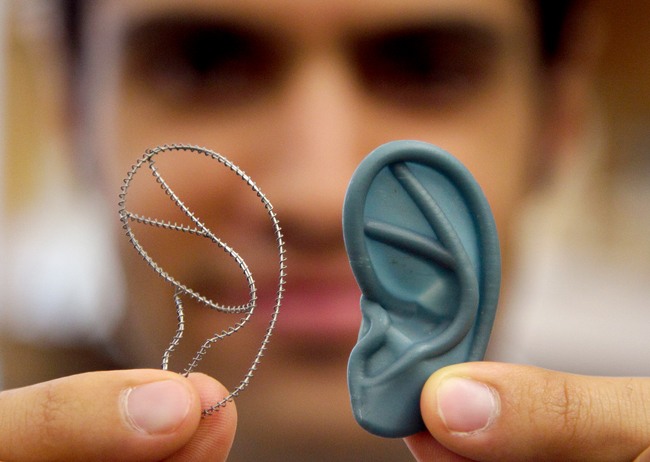BOSTON — Scientists are growing ears, bone and skin in the lab, and doctors are planning more face transplants and other extreme plastic surgeries. Around the country, the most advanced medical tools that exist are now being deployed to help America’s newest veterans and wounded troops. Now those who served are coming home, and projects that once had been languishing in labs are making strides and starting to move into clinics. The Associated Press reviewed the latest medical research to measure the progress and extent of novel treatments under way for wounded warriors. The results point to some surprising feats of surgery and bioengineering.
Growing new ears
Up to a thousand troops might need an ear, and prosthetics are not a great solution. A rod or other fastener is required to attach them to the head. They don’t look or feel natural and they wear out every couple of years. A matching ear grown from a patient’s own cells would be a huge improvement. They take a snip of cartilage from inside the nose or between the ribs and seed the scaffold with these cells. This is incubated for about two weeks in a lab dish to grow more cartilage. When it’s ready to implant, a skin graft is taken from the patient to cover the cartilage and the ear is stitched into place.
Bioengineering muscles, bone and skin
A soldier lucky enough to keep his arms and legs after a bomb blast still might lose so much of a key muscle, like biceps or quadriceps, that the limb can’t be used properly. In some cases, “the patient has lost so much muscle that there’s nothing left for the surgeon to sew together,” said Dr. Stephen Badylak, a regenerative medicine specialist at the University of Pittsburgh.
In other efforts, Pittsburgh and Rice University scientists are working on growing bone to fix jawbone and other facial defects. Researchers at Massachusetts General and Rutgers University are trying to grow eyelid muscles. Blindness can result from not being able to close an eyelid. Doctors also are testing various ways to make skin.
Beyond “bionic arms” to transplants
For all the advances that have been made in modern prosthetics, the arms and hands are not as effective as the legs and feet. Dozens of wounded troops would rather try a transplant. The government also estimates that up to 200 troops might need face transplants, although Dr. Bohdan Pomahac, a Boston surgeon who has done four face transplants on non-military patients, thinks only 50 to 100 ultimately will get one.
Advancing reconstructive surgery
Many troops remain disfigured or impaired despite multiple reconstructive operations. Tackling the toughest cases is the goal of Operation Mend, a program of the UCLA Medical Center, Brooke Army Medical Center in San Antonio and the Veterans Affairs Greater Los Angeles Healthcare System.















